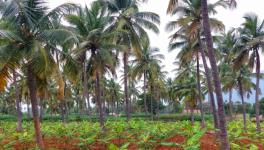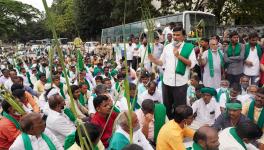The Manual for Drought Management, 2016 Won’t Let North Karnataka Be Declared Drought-hit

R V Deshpande, the revenue minister of the state of Karnataka, has acknowledged the insufficient rainfall in the 13 districts in the Northern region of the state, and the consequential drought. Karnataka has recorded heavy rainfall, this monsoon. However, the Northern districts of the state are untouched by the monsoon this year as well making this 14thyear of drought in the region. The revenue minister, however, has noted that due to the changes in the benchmark defining drought situation by the central government, it is not possible to declare the region as drought-hit.
The former government led by Siddaramaiah had opposed the Centre’s move to change parameters for drought assessment. Themanual for drought management of 2016, unlike the manual of 2009, not only has made the parameters to declare drought complex and stringent, but has also limited Centre’s scope to offer financial assistance to states in the eventuality of a drought.
Also read: Farmers Continue to Resolutely Struggle Against the Broken Promises of the Modi Government
Declaring a drought becomes difficult
The new manual proposes a complex matrix-based analysis to indicate the nature of the drought, i.e. ‘moderate’ or ‘severe’. This analysis, according to the manual, has to be based on what is called a Ground Truthing (GT) or Verification: The GT is to be conducted using a smart phone-based application. “The app shall record the GPS coordinates of the site and the photo of the state of crop, with the provision to upload these parameters on a computer server for archiving for post-facto analysis,” reads the manual. In this computerised analysis, the manual noted, “An estimation of crop damage/loss of 33% or more on the basis of field verification will qualify for the declaration of drought. However, for the drought to qualify as one of a ‘severe’ nature, the estimation of damage/loss to crops should be more than 50%.”
Also read: Five Factors That Will Shape Karnataka Poll Results
The manual has done away with the traditional annewari,paisewari, girdawarior crop cutting assessments in the determination of drought. According to the new scientific system, for a drought to fall under the ‘severe’ category and be eligible for central assistance, the state government has to prove severity in terms of three out of the four main impact indicators. These four impact indicators are: Crop Situation Related Indices, Remote Sensing based vegetation indices, Soil Moisture Based Indices and Hydrological indices. So far, the states had been following their own system of drought assessment and drought declaration. The new manual has made it extremely difficult for the state governments to declare droughts.
Deshpande – noting all the guidelines in the new manual – has said that the region can’t be declared drought-hit, so that they could avail the financial assistance of the central government. According to the India Meteorological Department, only 26 per cent of the Northern Interior Region of Karnataka has received rainfall, which too was insufficient. The Agriculture Minister of the state, N H Shivshankar Reddy had noted that if this dry spell continued for the next 10 days, it would be disastrous for the agriculture sector and the state would have to declare the region a drought-hit region.
Financial assistance for the drought hit region
Deshpande has said that the state has undertaken suitable measures to manage the situation. The government is supplying drinking water through tanks to 184 villages, which have acute shortage of drinking water. He has also clarified that there is no cash crunch with the district administration and it has Rs. 221 crores in its account; and under National Rural Employment Guarantee Act, 2005, the government has decided to provide 150 days’ daily wages to the farmers. These measures undertaken by the state government would certainly provide a relief to the distressed farmers, but does not provide the benefits that the drought declaration would have.
Also read: MSP For One Third of Total Production. What About the Rest?
The 2009 manual had systematically listed the roles and responsibilities of both the state and the central governments in responding to the drought situation. The manual was just a set of guidelines and was flexible regarding declaration of drought. Placing the responsibility of the drought relief on both the state and central government, it stated, “While it is primarily the responsibility of the State Government to manage drought, the Central Government also plays an important role in monitoring drought and providing financial assistance to the States.”
The 2016 manual, on the other hand, places complete onus on the state government to provide financial assistance for the drought-affected region. The manual, which gives mandatory guidelines and stringent indices for the state governments to declare drought, notes, “Relief operations are mounted in drought affected areas by the State Governments after the notification of drought using, inter alia, funds available under the State Disaster Response Fund (SDRF). In the event of drought of a severe nature, the State Government may seek assistance from the Central Government including financial assistance from National Disaster Response Fund (NDRF).” So, central government would provide relief only if the drought in the area fits the ‘severe’ bracket, according to the matrix-based analysis.
While the 2009 manual had directed the Centre and the state governments to keep funds reserved under Calamity Relief Funds (CRF) in the ratio 3:1 and National Calamity Contingency Fund (NCCF) for severe drought cases, the 2016 manual has kept the central government out of funding. Under the section of Memorandum for financial assistance, the manual says, “A Memorandum for assistance under the National Disaster Response Fund (NDRF) will be submitted within a week of the declaration of drought only if the calamity is of a severe nature.” Making it mandatory for the state governments to follow this manual, it also says, “[T]he Memorandum for assistance will mandatorily contain a copy of the State Government notification on drought, details of assessment of drought as per Table 3.10 (Impact indicators mentioned earlier) and details of village-wise field verification data.”
Speaking to Village Square, Mohan Gojamgunde, an agricultural officer fromLatur,remarked, “The indices for declaring severe drought are so strict that such droughts will occur only once in 10-15 years. Thus, the Centre won’t have to release any drought relief funds.”
Also read: Plight of North Karnataka Farmers, Silent State Government and Politics of BJP
Get the latest reports & analysis with people's perspective on Protests, movements & deep analytical videos, discussions of the current affairs in your Telegram app. Subscribe to NewsClick's Telegram channel & get Real-Time updates on stories, as they get published on our website.
























